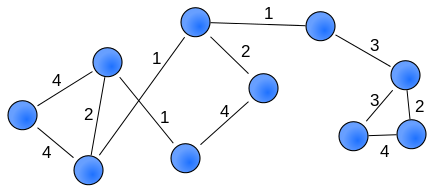Weighted network
A weighted network is a network where the ties among nodes have weights assigned to them. A network is a system whose elements are somehow connected (Wasserman and Faust, 1994).[1] The elements of a system are represented as nodes (also known as actors or vertices) and the connections among interacting elements are known as ties, edges, arcs, or links. The nodes might be neurons, individuals, groups, organisations, airports, or even countries, whereas ties can take the form of friendship, communication, collaboration, alliance, flow, or trade, to name a few.
In a number of real-world networks, not all ties in a network have the same capacity. In fact, ties are often associated with weights that differentiate them in terms of their strength, intensity, or capacity (Barrat et al., 2004) [2] and Horvath (2011).[3] On the one hand, Mark Granovetter (1973)[4] argued that the strength of social relationships in social networks is a function of their duration, emotional intensity, intimacy, and exchange of services. On the other, for non-social networks, weights often refer to the function performed by ties, e.g., the carbon flow (mg/m2/day) between species in food webs (Luczkowich et al., 2003),[5] the number of synapses and gap junctions in neural networks (Watts and Strogatz, 1998),[6] or the amount of traffic flowing along connections in transportation networks (Opsahl et al., 2008).[7]
By recording the strength of ties,[8] a weighted network can be created (also known as a valued network). Below is an example of such a network (weights can also be visualized by giving edges different widths):
Weighted networks are also widely used in genomic and systems biologic applications. (Horvath, 2011).[3] For example, weighted gene co-expression network analysis (WGCNA) is often used for constructing a weighted network among genes (or gene products) based on gene expression (e.g. microarray) data (Zhang and Horvath 2005).[9] More generally, weighted correlation networks can be defined by soft-thresholding the pairwise correlations among variables (e.g. gene measurements).[10]
Measures for weighted networks
Although weighted networks are more difficult to analyse than if ties were simply present or absent, a number of network measures has been proposed for weighted networks:
- Node strength: The sum of weights attached to ties belonging to a node (Barrat et al., 2004)[2]
- Closeness: Redefined by using Dijkstra's distance algorithm (Newman, 2001)[11]
- Betweenness: Redefined by using Dijkstra's distance algorithm (Brandes, 2001)[12] (details)
- The clustering coefficient (global): Redefined by using a triplet value (Opsahl and Panzarasa, 2009)[13]
- The clustering coefficient (local): Redefined by using a triplet value (Barrat et al., 2004)[2] or using an algebraic formula (Zhang and Horvath 2005) [9]
A theoretical advantage of weighted networks is that they allow one to derive relationships among different network measures (also known as network concepts, statistics or indices).[3] For example, Dong and Horvath (2007) [14] show that simple relationships among network measures can be derived in clusters of nodes (modules) in weighted networks. For weighted correlation networks, one can use the angular interpretation of correlations to provide a geometric interpretation of network theoretic concepts and to derive unexpected relationships among them Horvath and Dong (2008) [15]
Software for analysing weighted networks
There are a number of software packages that can analyse weighted networks, see Social network analysis software. Among these are the proprietary software UCINET and the open-source package tnet.
The WGCNA R package implements functions for constructing and analyzing weighted networks in particular weighted correlation networks.[10]
See also
Disparity filter algorithm of weighted network
References
- ^ Wasserman, S., Faust, K., 1994. Social Network Analysis: Methods and Applications. Cambridge University Press, New York, NY.
- ^ a b c A. Barrat and M. Barthelemy and R. Pastor-Satorras and A. Vespignani (2004). "The architecture of complex weighted networks". Proceedings of the National Academy of Sciences. 101 (11): 3747–3752. arXiv:cond-mat/0311416. Bibcode:2004PNAS..101.3747B. doi:10.1073/pnas.0400087101. PMC 374315. PMID 15007165.
- ^ a b c Horvath, S., 2011. Weighted Network Analysis. Applications in Genomics and Systems Biology. Springer Book. ISBN 978-1-4419-8818-8.
- ^ Granovetter, M (1973). "The strength of weak ties". American Journal of Sociology. 78 (6): 1360–1380. doi:10.1086/225469.
- ^ Luczkowich, J.J.; Borgatti, S.P.; Johnson, J.C.; Everett, M.G. (2003). "Defining and measuring trophic role similarity in food webs using regular equivalence". Journal of Theoretical Biology. 220 (3): 303–321. CiteSeerX 10.1.1.118.3862. doi:10.1006/jtbi.2003.3147. PMID 12468282.
- ^ D. J. Watts and Steven Strogatz (June 1998). "Collective dynamics of 'small-world' networks" (PDF). Nature. 393 (6684): 440–442. Bibcode:1998Natur.393..440W. doi:10.1038/30918. PMID 9623998. Archived from the original (PDF) on 2007-02-21.
- ^ Tore Opsahl and Vittoria Colizza and Pietro Panzarasa and Jose J. Ramasco (2008). "Prominence and control: The weighted rich-club effect". Physical Review Letters. 101 (16): 168702. arXiv:0804.0417. Bibcode:2008PhRvL.101p8702O. doi:10.1103/PhysRevLett.101.168702. PMID 18999722.
- ^ "Operationalisation of tie strength in social networks". 2009-02-06.
- ^ a b Zhang, Bin; Horvath, Steve (2005). "A general framework for weighted gene co-expression network analysis". Statistical Applications in Genetics and Molecular Biology. 4: Article17. doi:10.2202/1544-6115.1128. PMID 16646834.
- ^ a b Langfelder, Peter; Horvath, Steve (2008). "WGCNA: an R package for weighted correlation network analysis". BMC Bioinformatics. 9: 559. doi:10.1186/1471-2105-9-559. PMC 2631488. PMID 19114008.
{{cite journal}}: CS1 maint: unflagged free DOI (link)
- ^ Mark E J Newman (2001). "Scientific collaboration networks: II. Shortest paths, weighted networks, and centrality" (PDF). Physical Review E. 64 (1): 016132. arXiv:cond-mat/0011144. Bibcode:2001PhRvE..64a6132N. doi:10.1103/PhysRevE.64.016132. PMID 11461356.
- ^ U Brandes (2008). "On variants of shortest-path betweenness centrality and their generic computation". Social Networks. 30 (2): 136–145. CiteSeerX 10.1.1.72.9610. doi:10.1016/j.socnet.2007.11.001.
- ^ Tore Opsahl and Pietro Panzarasa (2009). "Clustering in Weighted Networks". Social Networks. 31 (2): 155–163. CiteSeerX 10.1.1.180.9968. doi:10.1016/j.socnet.2009.02.002.
- ^ Dong J, Horvath S (2007) Understanding Network Concepts in Modules. BMC Systems Biology 2007, June 1:24

- ^ Dong, Jun; Horvath, Steve (2008). Miyano, Satoru (ed.). "Geometric interpretation of gene coexpression network analysis". PLoS Computational Biology. 4 (8): e1000117. Bibcode:2008PLSCB...4E0117H. doi:10.1371/journal.pcbi.1000117. PMC 2446438. PMID 18704157.
{{cite journal}}: CS1 maint: unflagged free DOI (link)

